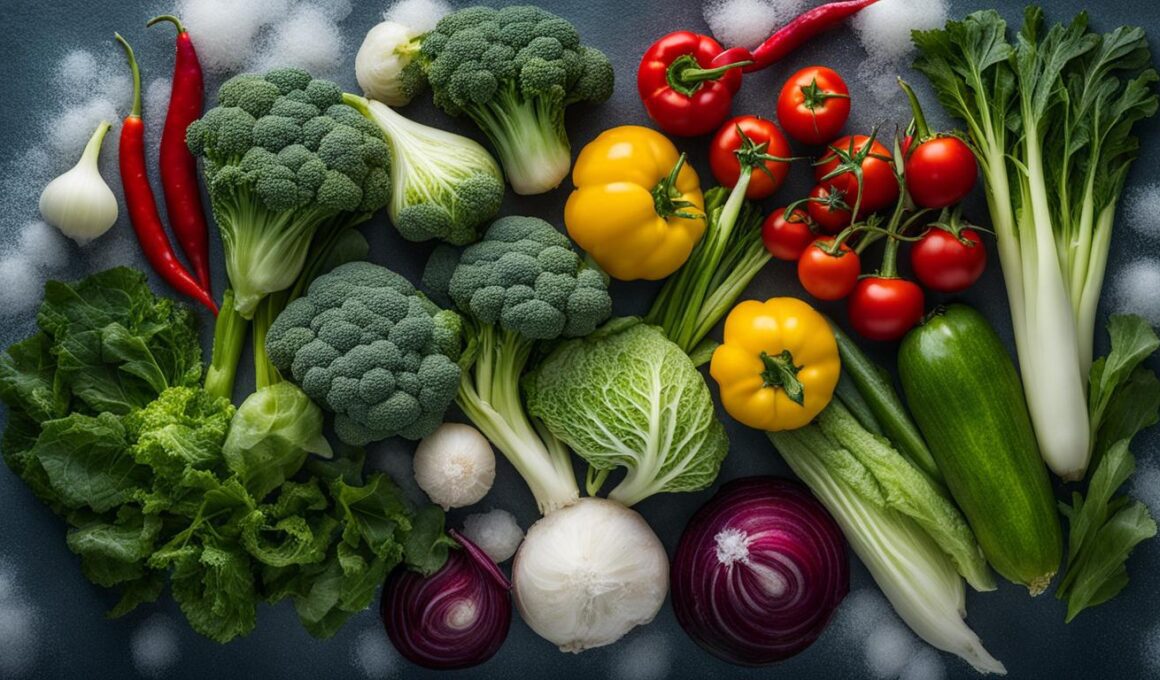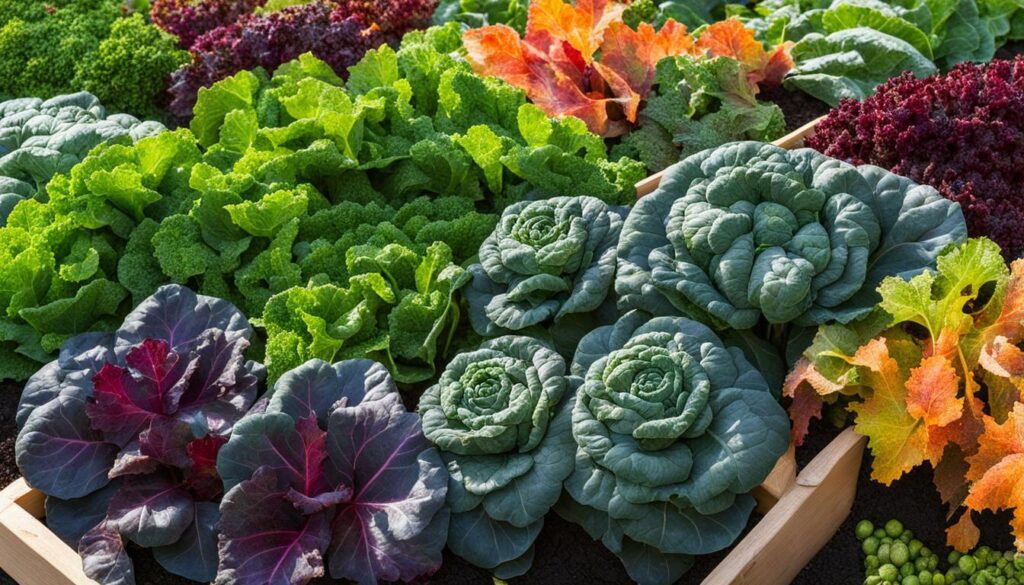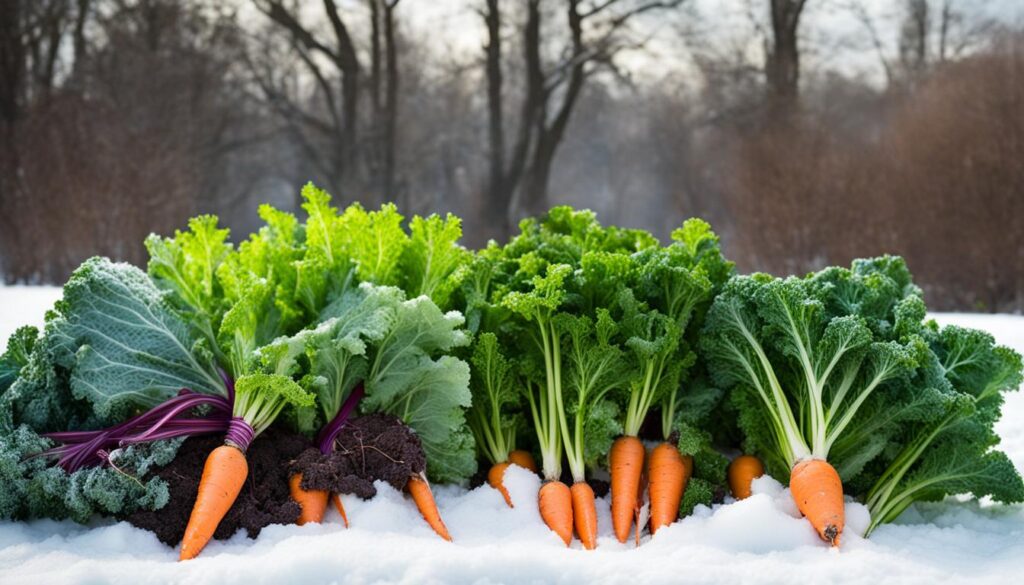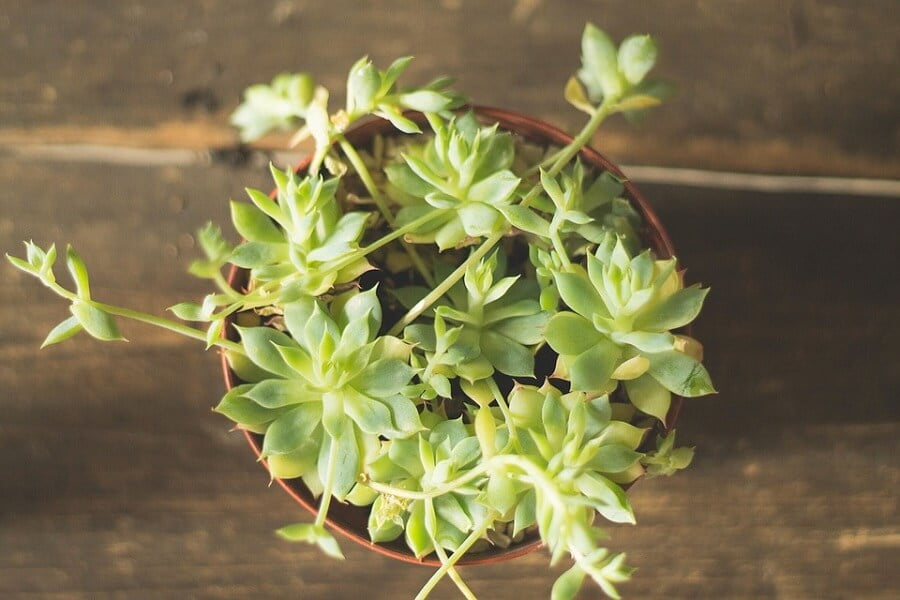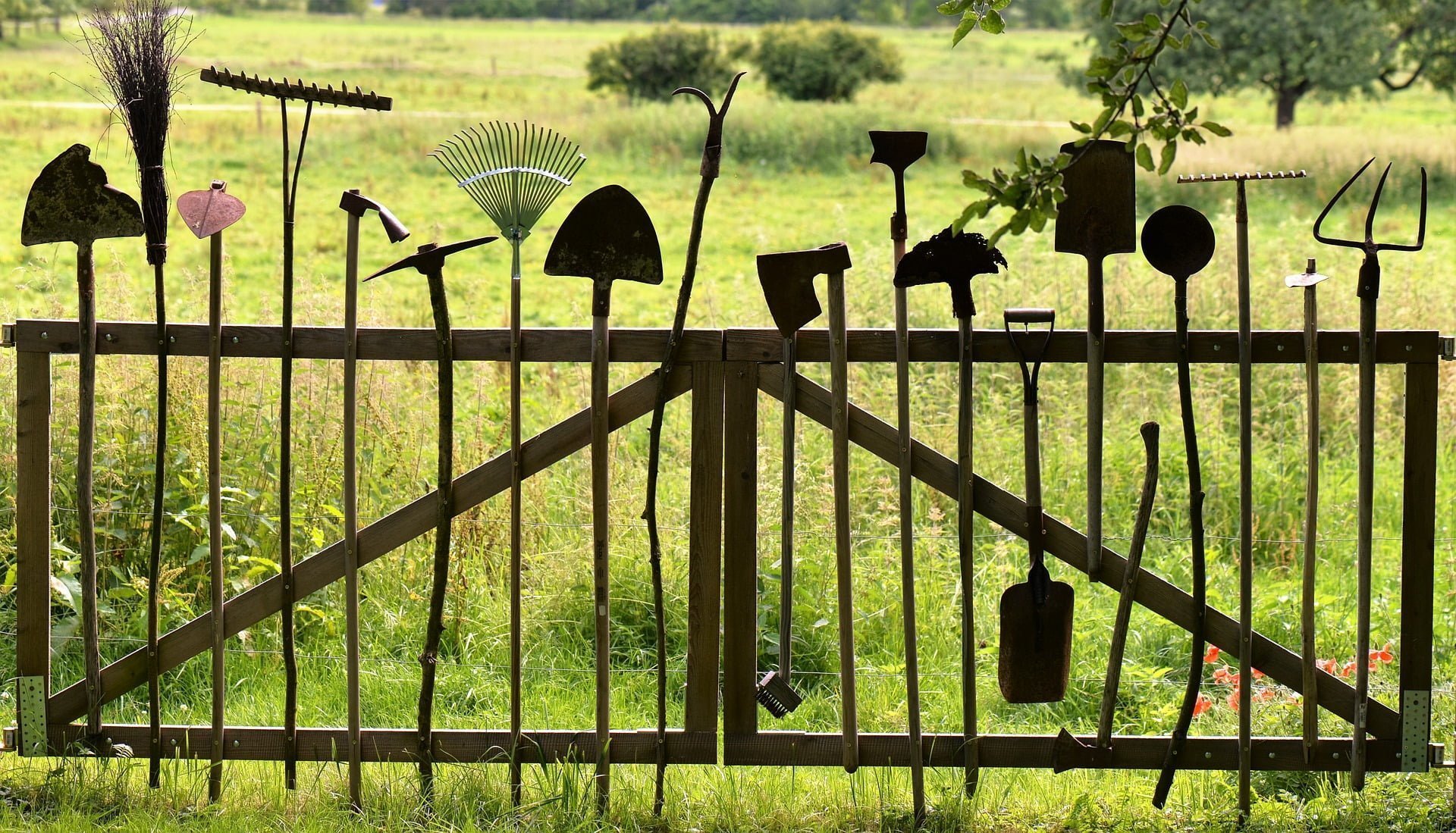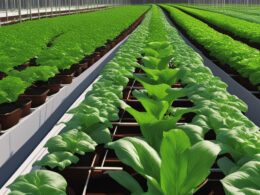When it comes to gardening, the changing seasons can bring challenges, especially in colder climates. But with the right knowledge and planning, you can still enjoy a bountiful harvest even during cold weather. Understanding vegetable cold hardiness is the key to success.
Cold weather vegetables, also known as cool weather vegetables, are a great choice for gardeners looking to grow in lower temperatures found in spring and fall. These vegetables, like broccoli, kale, and lettuce, thrive in cooler conditions and can withstand chilly nights.
But what about the colder months? That’s where hardy and semi-hardy vegetables come in. Hardy vegetables can tolerate hard frosts, making them perfect for fall harvests and winter growing in warmer regions. On the other hand, semi-hardy vegetables can withstand light frosts and can be grown throughout the winter in milder climates.
To determine which vegetables are suitable for your area, the USDA Freeze Map is a valuable resource. It provides information on the first freeze date in your region, helping you plan the length of your harvest season accordingly.
In this ultimate guide, we’ll explore the different types of cold hardiness in vegetables, from cool-weather varieties to hardy and semi-hardy options. We’ll also provide tips and insights for successful winter vegetable gardening, so you can maximize your harvest even during the coldest times of the year.
Key Takeaways:
- Cold weather vegetables thrive in lower temperatures found in spring and fall.
- Hardy vegetables can tolerate hard frosts and are ideal for fall harvests and winter growing in warmer regions.
- Semi-hardy vegetables can withstand light frosts and are suited for winter growing in mild-winter regions.
- Check the USDA Freeze Map for the first freeze date in your area to determine the length of the harvest season.
- By understanding vegetable cold hardiness, you can extend your growing season and enjoy fresh produce even during cold weather.
Hardy Vegetables for Fall Harvest and Winter Growing
When it comes to fall harvest and winter growing, hardy vegetables are your best bet. These veggies can tolerate hard frosts, making them perfect for colder climates and extending your growing season. Whether you want to keep your garden productive through the fall or enjoy fresh produce during the winter months, incorporating hardy vegetables is the way to go.
So, which vegetables fall into the hardy category? Some popular options include arugula, broccoli, collards, kale, spinach, turnip, and garlic. These resilient plants continue to grow and produce even after the first hard frost hits. By understanding their cold tolerance and utilizing the USDA Freeze Map, you can plan your harvest season accordingly and make the most of these hardy vegetables.
With their ability to withstand freezing temperatures, hardy vegetables provide a reliable source of fresh and nutritious food during colder months. Whether you’re looking for fall greens or winter root crops, incorporating hardy vegetables into your garden will ensure a bountiful harvest.
Table: Hardy Vegetables for Fall Harvest and Winter Growing
| Vegetable | Hardiness |
|---|---|
| Arugula | Hardy |
| Broccoli | Hardy |
| Collards | Hardy |
| Kale | Hardy |
| Spinach | Hardy |
| Turnip | Hardy |
| Garlic | Hardy |
By choosing hardy vegetables for your fall and winter garden, you can enjoy fresh greens, flavorful root crops, and more while other plants lie dormant. So, make space in your garden for these cold-tolerant veggies and reap the rewards of a fruitful fall harvest and winter growing season.
Semi-Hardy Vegetables for Winter Growing in Mild Climates
When it comes to winter vegetable gardening in mild-winter regions, semi-hardy vegetables are your go-to options. These resilient plants can tolerate light frosts (29 to 32 degrees F) and provide fresh produce throughout the winter season. If you are looking to maintain a productive garden during the colder months, consider adding the following semi-hardy vegetables to your winter growing lineup:
Table: Semi-Hardy Vegetables for Winter Growing
| Vegetable | Description |
|---|---|
| Cabbage | With its dense heads of leaves, cabbage is a versatile vegetable that thrives in cooler temperatures. It can be enjoyed raw in salads or cooked in various dishes. |
| Cauliflower | Cauliflower is a cruciferous vegetable that forms tight heads of white florets. It’s perfect for roasting, sautéing, or adding to soups and stews. |
| English Peas | English peas, also known as garden peas, are sweet and tender. They are excellent for adding fresh flavors to stir-fries, pastas, or side dishes. |
| Lettuce | Lettuce varieties like romaine, butterhead, and loose-leaf can withstand chilly temperatures and provide crisp, refreshing salads during the winter. |
| Onions | Onions, both bulb and green varieties, can be grown throughout the winter. They add depth of flavor to a wide range of savory dishes. |
| Rutabaga | Rutabagas are root vegetables that have a slightly sweet and nutty flavor. They are delicious roasted, mashed, or added to soups and stews. |
| Swiss Chard | Swiss chard is a leafy green vegetable with colorful stems. It can be enjoyed sautéed, steamed, or added to soups and stir-fries. |
To determine which semi-hardy vegetables to grow in your winter garden, it’s essential to check your area’s USDA Hardiness Zone. This classification system helps you understand the average low temperatures in your region and select suitable plants accordingly. In mild-winter regions like the Pacific Northwest, Southeast, and Southwest, semi-hardy vegetables thrive outdoors all winter long, allowing you to enjoy a continuous harvest.
By incorporating these semi-hardy vegetables into your winter gardening plans, you can take full advantage of your mild-winter climate and enjoy homegrown produce even when the temperatures drop. Whether you’re preparing hearty soups, fresh salads, or nutritious side dishes, these resilient vegetables will provide you with a bountiful harvest throughout the winter season.
Tips for Successful Winter Vegetable Gardening
If you’re planning to have a productive winter vegetable garden, there are a few key tips and strategies to keep in mind. By following these guidelines, you can ensure the success of your cool-season crops and enjoy fresh produce throughout the colder months.
Pest Management for Cool-Season Pests
Cool-season pests like slugs and aphids may still make an appearance in your winter garden, but the colder temperatures can actually make pest management easier. The slower pace of cold-weather growing gives you more time to monitor and control any potential infestations. Regularly inspect your plants and remove any pests you find. You can also introduce natural predators, such as ladybugs or beneficial nematodes, to help control unwanted insects.
Watering in Winter
During winter, the combination of rainfall and lower temperatures reduces the need for regular watering. However, it’s still important to ensure your plants receive adequate moisture. Using soaker hoses or drip irrigation systems can help deliver water directly to the plants’ roots, reducing evaporation and water waste. Monitor the soil moisture regularly and adjust your watering schedule accordingly.
Amending Soil for Winter Growing
Before planting your winter vegetables, it’s essential to amend the soil to provide optimal nutrition for your plants. Add organic matter, such as compost or well-rotted manure, to improve soil structure and nutrient content. You can also incorporate balanced organic fertilizer to ensure your plants have access to essential nutrients during the reduced microbial activity of winter.
Timing Your Planting
The timing of your planting is crucial for a successful winter vegetable garden. Consult your USDA Hardiness Zone and local extension office for specific recommendations on when to start planting different crops. Some vegetables, like kale and spinach, can be planted as early as late summer or early fall for a long harvest season, while others may need to be planted in late fall to mature during the winter months.
| Vegetable | Planting Time | Notes |
|---|---|---|
| Kale | Late summer to early fall | Can be harvested throughout the winter |
| Spinach | Late summer to early fall | Can be harvested throughout the winter |
| Carrots | Late summer to early fall | Harvest in late fall or leave in the ground for winter storage |
| Radishes | Early fall | Quick-growing and can be harvested in late fall |
By following these tips for successful winter vegetable gardening, you can make the most of the colder months and continue to enjoy a bountiful harvest. From managing cool-season pests to proper watering and soil amendment, each step plays a crucial role in maintaining healthy and productive plants throughout the winter season.
How Can Cold Hardiness Information Help Prevent Sunburn on Tomato Plants?
Understanding cold hardiness information can assist in preventing tomato sunburn leaves. By knowing the temperature limits of tomato plants, growers can make informed decisions about when to plant and protect their crops from extreme cold and heat, ultimately reducing the risk of sunburn on tomato plants.
Conclusion
Understanding vegetable cold hardiness is key to creating a resilient garden and increasing your harvest even during cold seasons. By selecting cool weather vegetables and choosing hardy or semi-hardy varieties, you can enjoy fresh produce throughout the fall and winter.
Utilize the USDA Freeze Map and your USDA Hardiness Zone to carefully plan the timing and variety selection for your winter vegetable garden. By leveraging this information, you can optimize your planting schedule and ensure the success of your cold-season crops.
With proper care and attention, you can extend your growing season and savor the rewards of your labor all year round. Don’t let the chilly weather deter you from enjoying a bountiful harvest. Embrace vegetable cold hardiness and create a flourishing garden that thrives in the face of cold seasons.
FAQ
What are cool weather vegetables?
Cool weather vegetables, such as broccoli, kale, and lettuce, thrive in lower temperatures found in spring and fall.
What are hardy vegetables?
Hardy vegetables can tolerate hard frosts (25 to 28 degrees F) and are perfect for fall harvests and winter growing in warmer regions.
What are semi-hardy vegetables?
Semi-hardy vegetables can tolerate light frosts (29 to 32 degrees F) and can be grown through winter in mild climates.
How can I determine the length of the harvest season?
Check the USDA Freeze Map for the first freeze date in your area to determine the length of the harvest season.
What are examples of hardy vegetables?
Examples of hardy vegetables include arugula, broccoli, collards, kale, spinach, turnip, and garlic.
What are examples of semi-hardy vegetables?
Examples of semi-hardy vegetables include cabbage, cauliflower, English peas, lettuce, onions, rutabaga, and Swiss chard.
How can I plan my harvest season?
Use the USDA Freeze Map to determine the approximate date of the first freeze in your area and plan your harvest season accordingly.
Can hardy vegetables continue to grow after the first hard frost?
Yes, hardy vegetables continue to grow and produce in the garden for weeks after the first hard frost.
Can I grow semi-hardy vegetables throughout the winter?
Yes, semi-hardy vegetables can be grown throughout the winter in mild-winter regions.
How can I determine which vegetables to grow in winter?
To determine which vegetables to grow in winter, check your area’s USDA Hardiness Zone to understand the average low temperatures.
Where do semi-hardy vegetables thrive outdoors all winter long?
Semi-hardy vegetables thrive outdoors all winter long in mild-winter regions like the Pacific Northwest, Southeast, and Southwest.
What are some key differences in winter vegetable gardening?
Winter vegetable gardening is similar to warm-weather gardening with a few key differences.
Are there pests to be aware of in winter vegetable gardening?
Yes, cool-season pests like slugs and aphids may appear, but the slower pace of cold-weather growing makes pest management easier.
Do I need to water my winter vegetables?
Winter rains can reduce the need for watering, but soaker hoses and drip irrigation are still recommended for efficient watering.
How can I ensure my winter vegetables have ample nutrition?
Amending soil with organic matter or fertilizer before planting ensures ample nutrition for plants during reduced microbial activity.
How do I know when to plant winter vegetables?
Plant winter vegetables based on your specific USDA Hardiness Zone and local extension office recommendations for timing.
Why is understanding vegetable cold hardiness important?
Understanding vegetable cold hardiness allows you to have a resilient garden and increase your harvest even during cold seasons.
How can I enjoy fresh produce throughout the fall and winter?
By growing cool weather vegetables and choosing hardy or semi-hardy varieties, you can enjoy fresh produce throughout the fall and winter.
How can I plan my winter vegetable garden?
Utilize the USDA Freeze Map and your USDA Hardiness Zone to plan the timing and variety selection for your winter vegetable garden.
Can I extend my growing season with proper care?
Yes, with proper care and attention, you can extend your growing season and enjoy the fruits (or vegetables) of your labor all year round.





